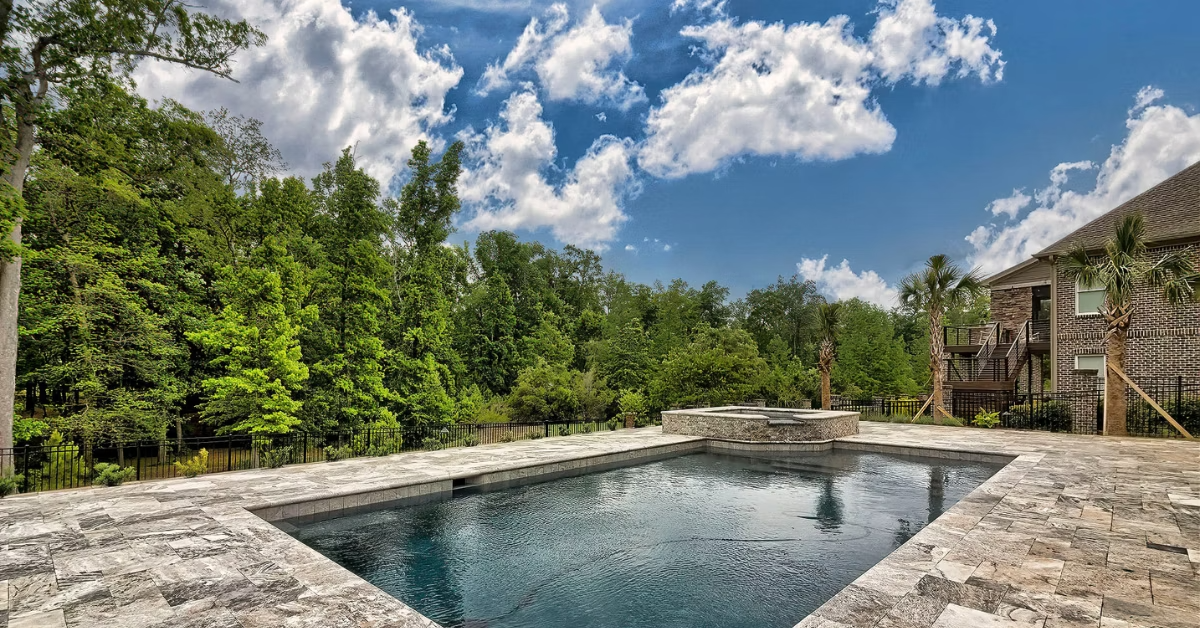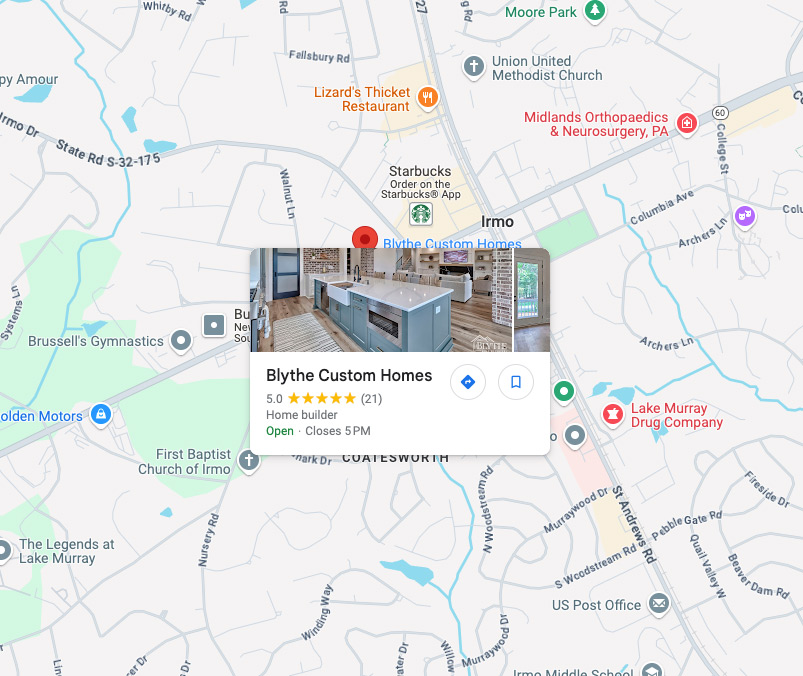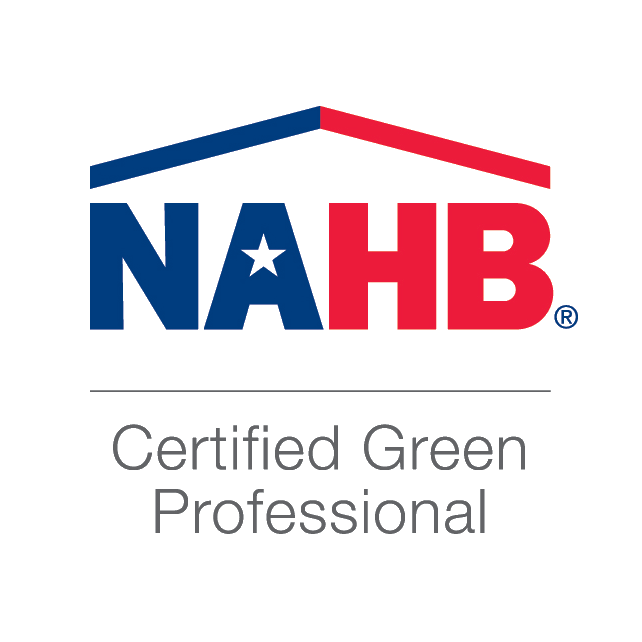Silver travertine pool deck coping and French pattern silver travertine decking for one of our latest builds.
On a hot summer day, there is no better way to beat the heat than to take a dip in your own private pool. Get the family together. Invite all your friends. Make some memories you’ll all cherish for a lifetime.
If you haven’t taken the plunge to build a custom pool yet, but you are thinking about it, maybe you haven’t heard of travertine pavers for pool decks. Or you aren’t sure what they are all about. You may want to thank us later for introducing you to this material and putting it on your radar. It’s an option worth considering.
Travertine pavers are a very popular pool decking materials for luxury pools today. But what is travertine? And why are so many luxury homeowners choosing to use this stunning material to create their own backyard paradise? We’ll take a look at the answers to these questions and more, as well as explore the pros and cons of travertine below.

In Turkey, there is a cliff area called, Pamukkale (pictured above), where travertine has formed into pools and ridges. It is one of the most beautiful natural rock formations in the world.
What Is Travertine?
Travertine is a natural stone, specifically (for the geology buffs out there), a sedimentary rock. It begins as limestone and requires a special set of circumstances to develop into travertine.
How is travertine formed?
Travertine rock forms near the earth’s surface around hot springs and in caves. When hot mineral water, from geo-thermally heated hot springs, and limestone are in contact with each other for long periods, travertine forms as it is compressed into a solid structure. It has fine holes due to hot water and gases being forced out during the formation process.
Spring water with high levels of calcium bicarbonate slowly adds to stalagmite formation, or the water falls over the edge of a cliff, cooling and hardening to leave calcium deposits that look like a frozen waterfall, as in the image below. It looks like ice but it’s white travertine stone.
Is Travertine Marble?
Both travertine and marble are natural types of stone, but each of these materials has its own properties. They are not the same thing.
Marble is formed when limestone or travertine (both sedimentary rocks) undergo heat and pressure over a long time. The stone recrystallizes to be a bit harder than travertine, which allows it to shine beautifully when it is polished.
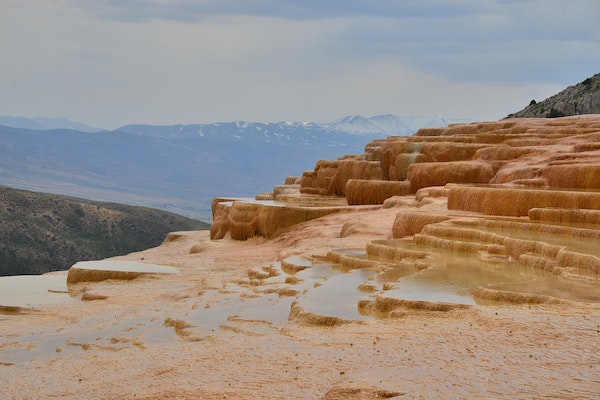
The stepped travertine terraces of Badab Soort in Mazandaran Province, Iran.
Where Does Travertine Come From?
There are large deposits of travertine in Turkey, Mexico, Chine, Peru, Iran, and — most famously — in Italy. In ancient Rome, mineral springs in Tivoli built up a layer of travertine over 300 feet thick. This stone was used to construct the famous Roman Colosseum that is still standing to this day. Travertine became the most popular building material in the area. The Tivoli quarry is still in use today.
In the USA, you can find travertine in Yellowstone at Mammoth Hot Springs, although it is not being mined there.
Travertine has been used across millennia for building great civilizations. And it continues to capture the hearts of builders, designers, and homeowners today.
What Is Travertine Used For in Building Today?
It’s often used for outdoor applications like patios, pools, driveways, walkways, and stairs because of its beauty, reliability, and durability.
Indoors, travertine is prized as a functional, earthy, and timeless building material for floors, walls, countertops, backsplashes, showers, tub surrounds, bathroom vanity tops, and fireplaces.
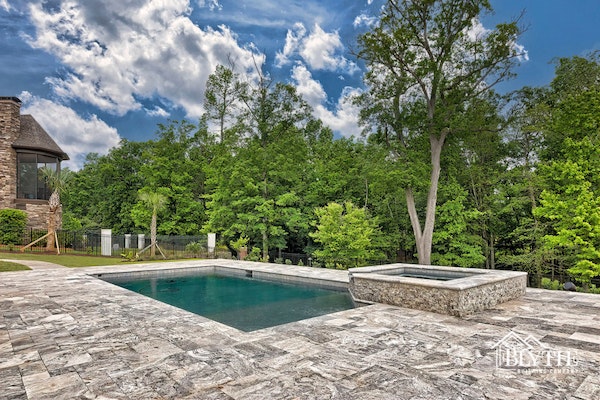
Silver travertine pool coping and French pattern silver travertine decking for custom pool and spa.
What Are the Pros and Cons of Travertine Pavers for Pool Decking?
Travertine has stood the test of time across many cultures, centuries, and continents. So it’s no surprise that people still love it today. Let’s look at why people want travertine stone around their pools as pavers for decking and coping for pools.
10 Pros of travertine pavers
Here are some of the biggest advantages of travertine.
Relatively non-slip texture
Pool decks are going to get wet. So it’s critical to choose a decking material that won’t be super slippery to help prevent falls and injuries. The pores in travertine absorb water and help prevent water from standing on the surface by promoting drainage. For the best non-slip surface, consider treating with a special non-slip product.
Heat resistant
If you live in the South, you know that some materials can get so hot in the summer sun that they can easily burn bare feet. One of the wonderful things about travertine stone is that it keeps your feet cool and you don’t have to worry about your friends or family burning themselves.
Timeless natural beauty
Travertine has a natural variation in color and pattern that never goes out of style and evokes a sense of luxury and opulence.
Improves your home’s value
Buyers love to see a travertine patio or pool deck. Because of their classic beauty and durability, these pavers can boost your resale value.
Durable and reliable
A travertine deck lasts for a very long time. You can expect well-maintained pavers to last many decades. Some last over one hundred years. This stone can handle high residential traffic indoors or outdoors.
Less expensive than marble or granite
You may be wondering, “Is travertine expensive?” There is a wide range of pricing options for travertine. But, generally, it costs less than marble or granite. The lower price point makes it a fantastic option for those who want to use natural stone.
The higher quality you buy, the more rare the type you desire, or the more polished or treated it is, the more it will likely cost.
Easy replacement
If something should happen to one paver, it’s usually pretty simple to take one travertine paver out and substitute it with another.
Many color options
Travertine stone comes in a variety of shades that can fit practically any color palette. And by using certain sealants, you can deepen the hues if you’d like a darker color.
Won’t fade or effloresce
Travertine doesn’t fade over time so you don’t have to worry about the color changing due to exposure to the sun and elements. And it doesn’t produce that white, salty powder that some pool deck materials do.
Environmentally friendly
This stone is a great option for those who want to use non-toxic products that will be more protective of the environment. This is a big advantage over using marble or porcelain.
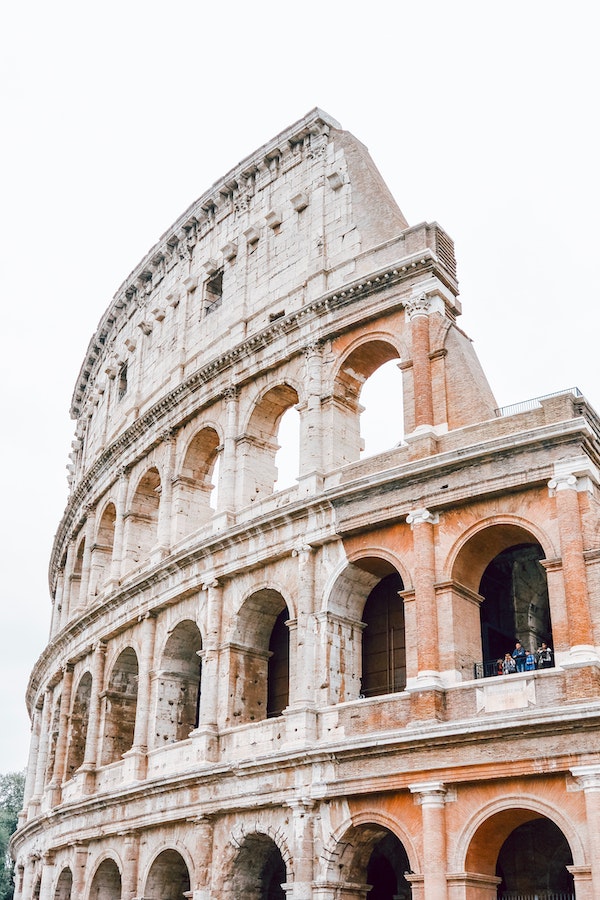
The Roman Colosseum is made of travertine stone, showcasing the durability of this material.
5 Cons of travertine pavers
Here are some of the disadvantages of travertine. Thankfully, most of them can be overcome with proper sealing and maintenance.
Softer than marble or granite
The softness of this stone makes it easier to work with than granite or marble. It’s fine for residential use, but travertine flooring isn’t used as much in commercial settings because marble can handle commercial-levels of high traffic better.
This quality is an advantage in some ways. Travertine for a pool deck can weather to a degree, particularly if it is not sealed. any people love the weathered look of travertine pool decking over time so much that they prefer to leave their stone unsealed. Remember that the Roman Colosseum is still standing, so this is a very strong material.
Porous
The porousness of outdoor travertine tile or pavers makes it relatively slip-resistant and textured for natural stone, which is great for a pool deck or patio. But the porousness means there are tiny holes that could become more noticeable over time with weathering. This can be avoided by grouting the holes and sealing the stone.
Like most natural stone, sealing may be advisable
A travertine patio may not have to be sealed, but it could be recommended, as with many types of natural stone. Especially for the lower-quality level stone. Talk with your contractor about whether you’ll want to seal your pavers or if it will be okay to leave them unsealed and whether a higher-quality stone may be more advantageous. Please note that if you have a salt water pool or live in certain climates, however, sealing will be more important.
If you do seal your outdoor travertine pavers, consider a high-quality, breathable sealer. (Please note that indoor travertine tile should be sealed.)
Sweeping is usually most of the cleaning needed. You can also clean the pavers with warm water and a sponge or mop.
May be sensitive to harsh chemicals
Avoid spilling acidic beverages or chlorine on your pavers. And use cleaning products meant for stone rather than using vinegar-based cleaners (including most “green cleaners”) or very alkaline cleaning products on a travertine pool deck to prevent problems.
To minimize issues issues, consider sealing your travertine pool deck with a high-quality product.
Very cold climates require high-quality stone and sealant
If you live in an area with a lot of long freezing winters, standard grade, untreated travertine may not be the best material to use untreated since it can be prone to water issues.
Thankfully, if you choose a high-grade, very dense travertine and it is sealed, this beautiful stone has fewer holes and can generally handle harsh climates. Be sure to talk with your builder about what type is best for your climate.
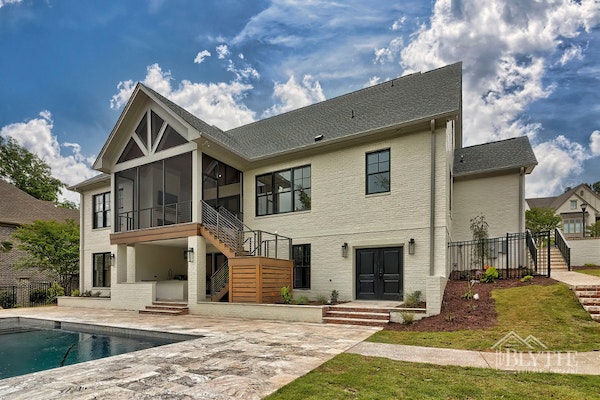
A French Country Modern home with painted brick and steel windows and a backyard custom in-ground pool with silver travertine pavers.
What Types of Travertine Pavers Are Available?
For outdoor use, you can find travertine pavers in different textures and styles.
Brushed
Using a wire brush, a new texture is added to the stone for a unique look. Brushed travertine provides extra traction to avoid slips.
Chiseled
Chiseled travertine has distressed edges and works well for driveways, patios, or walkways outdoors.
Filled
Any holes are filled with grout for a smoother look.
Honed
Honed travertine has been sanded to have a matte look and smooth finish on the surface.
Tumbled
This is one of the most popular options now for pools, patios, and driveways. The edges have a rounded, weathered look. And the stone has lots of little holes and crannies. The look is textured, rustic, and non-slip.
Travertine tiles are also available for indoor or outdoor use.
What is cross-cut vs vein-cut travertine?
Cross-cut pieces show circular patterns in the stone after being cut at a 90-degree angle to the bedrock. There will be a variety of colors in a mottled effect and a smoother surface.
Vein-cut travertine is cut parallel to the bedrock. It reveals more of a layered effect and more little nooks and crannies.
What travertine pool deck colors are available?
You can find a lovely variety of muted colors like white, gold, noce (caramel), red, ivory, silver, or walnut pavers on the market at your favorite tile shop.

A modern travertine pool deck: French pattern travertine pavers for the pool decking for a French Country Modern home.
Ready for Your Own Custom Home and Travertine Pool Paradise in Columbia, SC?
At Blythe Building Company, we build luxury homes across the Greater Columbia, SC area. With over 100 custom homes built, we have plenty of experience and knowledge you can trust to walk you through building your dream home. We also build custom pools and spas for our custom home clients, as well.
See our latest projects at the bottom of our Portfolio page.
Please contact us today.
We build in areas like downtown Columbia, Lake Carolina, Lake Murray, Lexington, West Columbia, Pine Ridge, Irmo, and more.
Related
The Best Patio Flooring Ideas for Your Dream Patio
Backyard Patio Ideas: Enjoy Outdoor Living Year Round
Answers to Your Biggest Questions About Using Marble in Your Home
Do I Really Need an Outdoor TV to Watch TV Outside?
Is a Brick Backsplash Right for Your Kitchen? Pros and Cons
Resources
10 Uses for Travertine You Should Consider for Transforming Spaces

